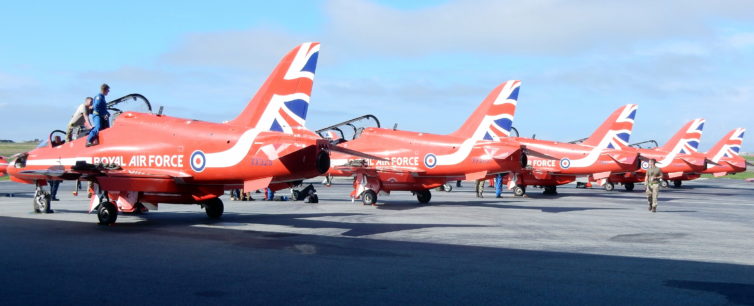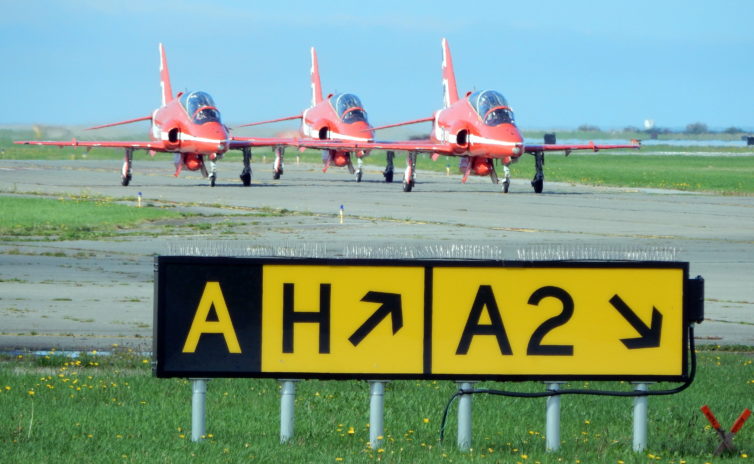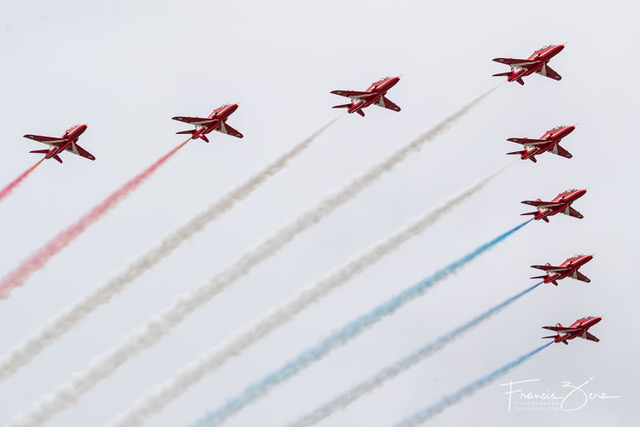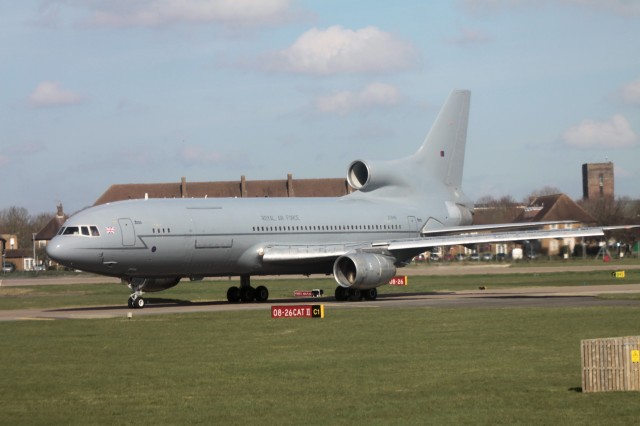
Now an Executive Officer with the Red Arrows, Squadron Leader Steve Morris has been flying with the RAF since 2002 – Photo: John Jamieson
This past September, I was fortunate enough to attend the Red Arrows’ media event in Vancouver, BC. During the event, I was given the opportunity to meet and interview Steve Morris, a senior pilot with the aerobatic team. In addition to learning about Steve’s day-to-day role with the Royal Air Force (RAF), he also talked about his career plans after aerobatics.
NOTE: In the interview, we discuss some of the team’s maneuvers and aerobatics. To provide some context, I’ll be including a few of my photos from the flypast. With a little help from the media guide, I’ve been able to identify some elements from their performance. I’ll do my best to explain the maneuvers as best that I can.

Truly a first-world problem: Do I livestream the arrival of the Red Arrows on my phone or capture the footage on my digital camera? – Photo: John Jamieson
Since the mid-1960s, the Royal Air Force Red Arrows have been the United Kingdom’s premier aerobatic display team. Under the RAF banner, the squadron has visited 57 countries and flown nearly 5,000 display shows.
In 2019, as part of their 55th-anniversary celebrations, the Red Arrows made their long-awaited return to North America. Following three days of position flying across the North Atlantic, the team arrived in Halifax on August 7th. After performing in New York, Chicago, Toronto, and Dallas, the team transitioned over to the West Coast.

AR writer/photographer Francis was also lucky enough to snap a few photos when they were in Seattle
With receptions planned in the Pacific Northwest, AirlineReporter was invited to the Red Arrows Arrival Event in Vancouver, BC. I was fortunate to be in town during their visit and eagerly accepted the invitation.
Before getting into the meat of the post, yes I do actually have some Red Arrows swag to give away. For a chance to win, keep reading and some swag could be on your way! Now, a quick history lesson.

Lockheed L1011 Tristar, KC 1; ZD950; callsign ’œFAGIN 12’. Backtracking along the main runway, alongside ZD948 ’œFAGIN 11’ – Photo: Graham Dinsdale
This story was written by Graham Dinsdale, of Ian Allan Aviation Tours in England, for AirlineReporter…
04:00 GMT (Greenwich Mean Time); my bedside alarm clock shatters the silence and causes my wife to stir; at last, I thought, keen to get started on what promised to be an awesome – but very sad – day. I had dozed the night away, my brain too active to shut down and allow me to get any sleep. I had reasons for my lack of sleep – I was to fly on a Royal Air Force (RAF) Lockheed L1011 Tristar in formation!
After the usual morning routine I was out the door by 4:30 a.m., and starting my car for the two-and-a-half hour drive across the countryside of Cambridgeshire, Northamptonshire, and Oxfordshire to the RAF’s huge air transport base at RAF Brize Norton. I anticipated possible delays due to dense fog and mist covering most of the route, and the morning rush-hour road traffic around the university town of Oxford didn’t help, so I allowed plenty of time to get to the rendezvous point: an off-base car park a quarter of a mile from the station’s main gate.
For those not familiar with British nomenclature, the RAF have ’œstations’ not ’œair bases!’ The fog and road traffic was not as bad as the internet advised, so I arrive early, at 6:25. Time to open up the flask of coffee and munch a biscuit. Over the next 90 minutes more and more of the invited media, and some very lucky aviation enthusiasts, arrived.



